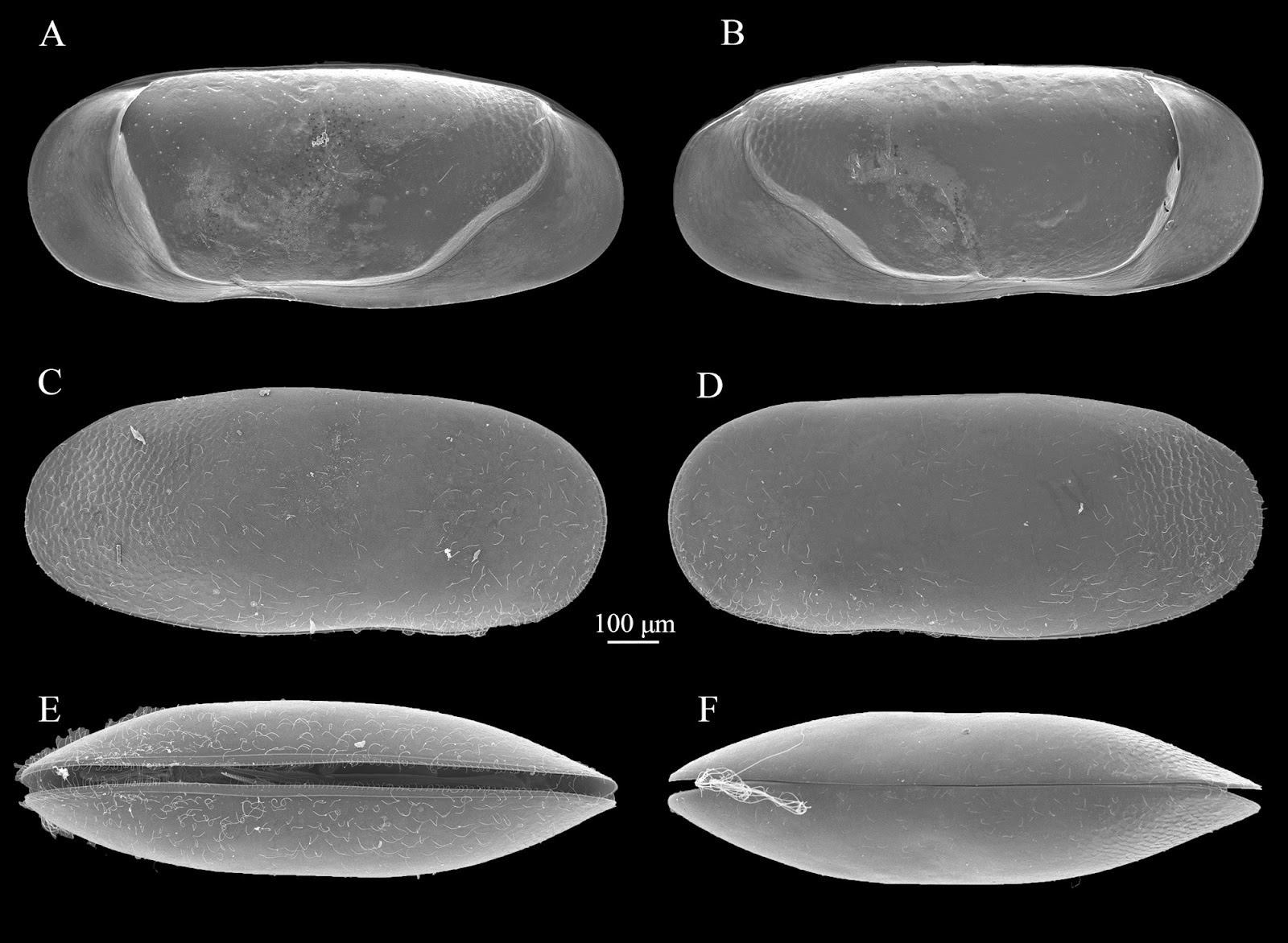Ostracods are small Crustaceans with a bivalved body plan; their
body is sandwiched laterally between two large valves, with the animal using
its legs to generate a current through the shell, enabling it to feed, and in
many cases swim (check). Ostracods are small (seldom much over a millimetre)
and can be very abundant, making them common fossils in many deposits. They
also often have distinctive shell ornamentation, enabling the identification of
species from valves alone, and are both fast-evolving and sensitive to a range
of environmental conditions, making them useful in both biostratigraphy (dating
rocks using fossils) and palaeoenvironmental reconstruction.
In a paper published in the journal Palaeontologia Electronica on in October 2014, Francesco Sciuto of the Palaeoecological Research Group at the
Department of Biological, Geological and Environmental Science at Catania University describes a new species of Ostracod from silty sands determined to
date from the Galesian Stage (earliest Pleistocene, between 2.58 and 1.80
million years old) on the Capo Milazzo Peninsula in northeast Sicily.
The new species is placed in the genus Nemoceratina and subgenus Pariceratina
and given the specific name barrieri,
in honour of Pascal Barrier, of the Institut Polytecnique LaSalle-Beauvais, for
his work on the geology of Sicily.
Nemoceratina (Pariceratina) barrieriis
described from four right and two left valves, the largest of which is 700 by
324 μm. The valves are sub-triangular, with three elongate spines and numerous
finer spines and denticles.
Nemoceratina (Pariceratina)
barrieri.(1), Left valve, external
lateral view. Scale bar 200 μm. (2) Right valve, external
lateral view. Scale bar 200μm. (3) Left valve, external lateral view. Scale bar
200 μm. (4) Right valve, external dorsal view. Scale bar 200 μm. (5) Left valves,
external dorsal view partially slanting. Scale bar 200 μm. (6) Left valves,
external dorsal view partially slanting. Scale bar 200 μm. (7) Right valve,
internallateral view. Scale bar 200 μm. (8) Right valve, internal lateral view,
detail of the anterior marginal area. Scale bar 100 μm. (9) External lateral
view, normal pores. Scale bar 10 μm. (10) Right valve, internal lateral view,
detail of the posterior marginal area. Scale bar 50 μm. (11) Right valve,
internal lateral view, partially slanting. Scale bar 200 μm. (12) External
lateral view, normal pores. Scalebar 10 μm. Scuito (2014).
Ostracods of the subgenus Nemoceratina
(Pariceratina) first appeared in the
Triassic and are still extant. They are interpreted as being a deepwater species,
which is consistent with the find at Capo Milazzo, where it occurs in sediments
that have produced other deepwater species.
See also…
Ostracods are small Crustaceans with bivalve shells with a long fossil
record. They typically have ornate shells and are both fast evolving and
environmentally sensitive, making them useful to biostratigraphers...
 Three dimensional soft tissue preservation in a Myodocope Ostracod from the Herefordshire Lagerstätte.
Three dimensional soft tissue preservation in a Myodocope Ostracod from the Herefordshire Lagerstätte.
Ostracods are small Crustaceans which conceal their bodies between two
large valves in a bodyplan convergent with the unrelated Bivalve
Molluscs and Brachiopods. They have an extensive fossil record,
beginning in the Late Cambrian, and are probably the most abundant
fossil Crustaceans, largely due to their...
Follow Sciency Thoughts on Facebook.


